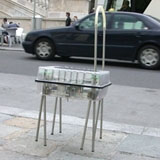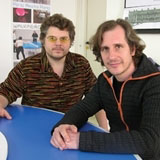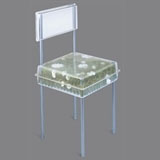Profile: Walking-Chair

Walking-Chair has made its name with unlikely designs, such as a chandelier for a bare light bulb, and composes a song for each product. Hannah Booth talks to Fidel Peugeot, one half of the quirky duo
At Designersblock’s 2002 show in the Bargehouse, by London’s Oxo Tower, it was unusually busy around one corner of the third floor. Crowds of hip young things, beer in hand, were gathered around two young designers, one born in Switzerland, the other in Italy. The attraction? A remote control chair with walking legs (see top picture). It was funny, surreal, cute and enchantingly anthropomorphic.
Six months later, the two designers – Fidel Peugeot and Karl Emilio Pircher (pictured below – left to right) adopted the name of their quirky product and set up a multi-disciplinary practice in Vienna, called Walking-Chair. This month, they’re back in London at the Aram Gallery to show off the results of nearly four years in business. The chair perfectly encapsulates Walking-Chair’s approach to product design/ playful, original, thoughtful and experimental.
The pair have since designed, among other products: Ping meets Pong , a bespoke circular hybrid of a conference table and a ping-pong table, which has sold 100 pieces worldwide; Bottleboy, a clothing hook made from a crushed plastic bottle; a crystal chandelier designed to hang over a bare lightbulb; a revolving sofa manufactured by Austrian company Kohlmaier and, most recently, a stool for Wiesner Hager, which launches at this month’s show in London.

‘Everything starts with our own ideas – clients come to us to talk about manufacturing,’ says Peugeot. ‘We find it hard to approach people direct.’ An odd and potentially self-defeating approach, perhaps, but it works. Business is good: they appointed a third partner this year, Sylvia Sauermann, to branch out into architecture (they are currently finishing their first architectural project, a water park in Bosnia and Herzegovina) and have moved into swanky new offices in a former grand café in central Vienna.
But Walking-Chair retains its quirkiness. ‘We like to describe our products as songs,’ Peugeot says. Every product has a short song attached to it: ‘Hey furniture, have something to say’ or ‘You say ping, we say pong’. It’s easy to mock, but the pair takes it seriously. ‘Music is a strong means of branding – look at McDonald’s and “I’m lovin’ it”. It’s genius,’ says Peugeot.
Peugeot and Pircher met through the Lomographic Society in Vienna in 2000 (the Lomo is the iconic camera invented in Russia and brought to Vienna). Peugeot was a typographer, Pircher a product designer who had studied under Ron Arad in London. They joined forces to work for a new mobile company, Telepong, but it collapsed following events of 11 September 2001 and they decided to strike out alone. Walking-Chair was founded in 2003.
Peugeot continues to design typefaces for magazines such as Wallpaper and GQ, and digital fonts for mobile phone clients, but all projects are collaborative. ‘We combine our skills in graphic, product and interior design, and in architecture,’ he says.
The man responsible for Walking-Chair’s exhibition is product designer and Royal College of Art lecturer Daniel Charny. ‘There is a huge social agenda behind the work,’ he says. ‘The ping-pong table breaks down the hierarchy of a traditional conference table. It’s about communication. Like El Ultimo Grito, Marti Guixe, Tord Boontje and Paul Cocksedge, their work is characterised by a strong sense of authorship – they’re not just improving on existing designs, they’re coming up with personal ideas. It’s impossible to be 100 per cent original, but it’s a matter of attitude.’

The ‘mad Austrians’, as Charny calls them, may be unconventional, but ‘they’re very serious, even when they joke’. ‘Take the songs they write about each product – they’re terrible, but it’s important to them. There’s no sense of irony about it, like you’d find in the UK,’ he points out. Walking-Chair is part of a growing scene of idiosyncratic Viennese design groups, including product design group Eoos (Profile, DW 31 March 2005). Indeed, a handful of emerging designers from Vienna, including Lucy D, BKM and Polka, are exhibiting work alongside Walking-Chair.
Charny is hoping to establish the gallery at Aram’s Covent Garden emporium as London’s only design gallery (‘Well, can you think of another?’ he challenges) with the tag line, ‘For experimental or new design’. Next up is an exhibition by Spanish designer Jaime Hayon (Profile, DW 9 March) in September.
And the Walking-Chair? What became of that? There are now five in existence, says Peugeot: two with collectors in Japan and Milan, two in its Vienna studio and one coming to London. ‘If we ever get an order for one, we produce it. Each one is handmade. I’d love to stage an exhibition – 20 international designers, each creating their own version. It would be like a little population of Walking-Chairs. Wouldn’t that be nice?’
Walking-Chair & Other Walking Things from Vienna runs until 14 July at the Aram Gallery, 110 Drury Lane, London WC2
-
Post a comment



